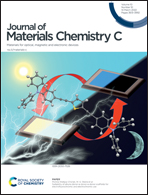A copper-based 2D hybrid perovskite solar absorber as a potential eco-friendly alternative to lead halide perovskites†
Abstract
Hybrid organic–inorganic perovskites (HOIPs) have attracted considerable attention for their scientific and technological potential in photovoltaics and optoelectronic devices. Recently, two-dimensional (2D) HOIPs have become established as useful active layers for photovoltaic applications, offering adjustable electronic levels, high charge carrier mobilities, and simplicity of thin-film device fabrication. In this work, we describe the preparation of a new Cu-based 2D hybrid perovskite, with the structural formula (C6H10N2)[CuCl4], of which crystallographic, spectroscopic, optical and magnetic properties have been studied and analyzed. The compound exhibits dominant ferromagnetic interactions. Fits of the χ(T) data to the 2D-ferromagnetic layer model yielded C = 0.456(2) emu-K mol-Oe−1 and J = 5.5(1). Analysis of electromagnetic absorption and reflectance properties through the visible and near-infrared indicate an optical band gap of 1.24 eV (absorption) or 1.23 eV (reflection) and a direct, spin-forbidden electronic transition giving rise to a strong absorption band centered at 740 nm, which allows it to absorb a large portion of the solar spectrum. Although the absorption coefficient is lower than lead halide perovskites, it is greater than 1000 cm−1 throughout the visible spectrum up to 1000 nm, giving the material potential as a solar absorber if relatively thick (∼5 μm) films are used. The nature of the electronic transition and frontier electronic states were studied by DFT and reveal valence and conduction bands arising from repeating CuCl4 square planar structural units composed of hybridized Cl 3px,y orbitals and Cu 3dx2−y2 orbitals. The electronic structure and optical properties indicate that the material might be able to serve as a non-toxic alternative to lead-based HOIPs in some applications.



 Please wait while we load your content...
Please wait while we load your content...